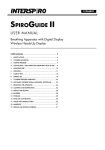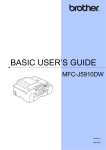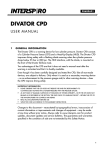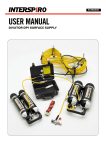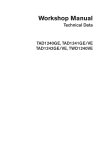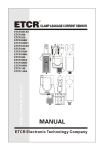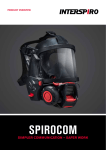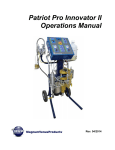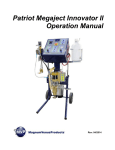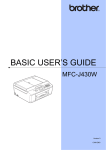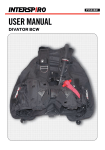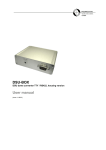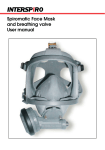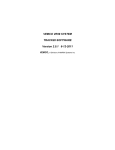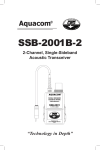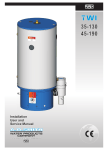Download SERVICE AND REPAIR MANUAL DIVATOR DP1
Transcript
MODULE 2-3 SERVICE AND REPAIR MANUAL DIVATOR DP1 Surface Supply © 2011 Interspiro AB, Sweden. This publication contains or refers to information protected by copyright legislation. All rights reserved. Interspiro® and Spiromatic® are registered trademarks that are the property of Interspiro. This publication must not be copied, photocopied, reproduced, translated or converted into any electronic or machinereadable form - in parts or in its entirety - without the written consent of Interspiro. Contents 1 INTRODUCTION..........................................................................................................................5 1.1 GENERAL Service steps.................................................................................................................................................................... 5 1.2The surface supply unit................................................................................................................................................................. 5 2 Annual SERVICE.......................................................................................................................6 2.1Tools & Consumables...................................................................................................................................................................... 6 2.2 Service kits . ................................................................................................................................................................................... 7 2.3 Cleaning............................................................................................................................................................................................. 8 2.4 Checking............................................................................................................................................................................................ 8 2.5 ANNUAL service............................................................................................................................................................................... 10 3six-Year service..................................................................................................................13 3.1 Tools and consumables................................................................................................................................................................ 13 3.2 Service kits..................................................................................................................................................................................... 14 3.3 Cleaning........................................................................................................................................................................................... 15 3.4 Checking.......................................................................................................................................................................................... 15 3.5 SIX-YEAR SERVICE............................................................................................................................................................................. 17 4 Repair....................................................................................................................................29 4.1 Repair............................................................................................................................................................................................... 30 5 Storage..................................................................................................................................37 SERVICE AND REPAIR MANUAL DIVATOR DP1 1 INTRODUCTION 1.1 GENERAL Service steps Thisserviceandrepairmanualdescribestherecommended service as well as repair of the Divator DP1 Surface Supply Unit. uCleaning – before any service or repair it is recommended to completely clean the equipment according to the user manual. The recommended time between services, including replacement of service parts, is based on international standard requirements as well as on Interspiro's experiences and tests. uService – certain parts need to be replaced to ensure a high degree of safety. uChecking – certain parts listed in each section need to be checked. ServiceintervalsaredefinedintheServiceandTestSchedule in the user manual uTesting – service and/or repair work on the equipment shall always be completed by a full functional test. The technicians, performing any service or repair work on any Interspiro breathing apparatus, must be trained and certified by Interspiro on the specific apparatus. The manual is divided into three chapters describing: 1.2The surface supply unit uAnnual Service – including the operations to be performed and service parts to be replaced at an annual service The Surface supply unit consists of the following subassemblies: uSix-year uSurface supply panel with valve block, pressure gauge, warning whistle hose and cylinder connections. uRepair uDiving hose with reliving loops and P+ regulator with Service – including the operations to be performed and service parts to be replaced at six-year service. – set out instructions for the dismantling and assembling of the repairable assemblies. anti-freezing unit. Each chapter describes what needs to be done during service, provided that the equipment is not damaged. For such equipment, repair work can be done according to chapter Repair. SERVICE AND REPAIR MANUAL DIVATOR DP1 2 Annual SERVICE 1 Year u This chapter describes everything that needs to be done during annual service, provided that the equipment is not damaged. For damaged equipment, repair work can be done according to chapter Repair. This chapter is divided into the following parts, which should be carried out in chronological order: External cleaning of regulator unit with hoses. uChecks of cylinder connection, pressure gauge and hoses. uReplacement uFull of anti-freezing cap, inlet filter and O-ring in high pressure connection. functional test 2.1Tools & Consumables Tools PART No - Fixture, regulator 460 190 855 - Screwdriver, slotted, 5,5 x 100 460 190 767 - Hexagonal key 5 mm 460 200 008 - Spong - - Washing brus - - Vice - Consumables PARTs PART No. Clocking compund 460 190 846 Silicone lubricant 331 900 269 Curacid PSA Rinse, 1 L 336 921 330 Lint free cloth - NOTES or hand detergent, low pH SERVICE AND REPAIR MANUAL DIVATOR DP1 2.2 Service kits All service kits and service parts listed below shall be replaced during service. Surface panel PART No. NOTES O-rings & filter for high pressure connections, 1 unit 460 190 701 DP1 Regulator P+ PART No. NOTES Anti-freezing cap, 6 pack 460 190 507 6 x 336 100 425 DP1 T-stycke PART No. NOTES O-ring for T-pice, 10 pack 336 190 272 10 x 331 100 767 SERVICE AND REPAIR MANUAL DIVATOR DP1 2.3 Cleaning If you suspect that the hose has been affected by chemicals or that chemicals have penetrated the outer sheath, the hose should be replaced. 1. Assemble hose, surface unit and air supply (both connections must be connected). Open the cylinder valves. Before cleaning, check the pressure gauge reading. If the pressure gauge shows that the air cylinder pack contains less than 65 bar (6.5 MPa or 945 psi) the air cylinder pack must be replaced or filled before you continue. If the system has not already been pressurized, do so now. The lifetime of the high pressure hose is eight (8) years from when the hose was completely manufactured. The year of manufacture is determined by the date for the pressure test stamped on the hose connection nipples in the format “P” + YY. The eight (8) year life time applies only under the conditions that the hose is handled and inspected in accordance with safety bulletin “31574B01 – Divator DP1 Supply Hose/Lifeline” 2. Place the unit on a washing surface. Use low-pH hand detergent/soap, a washing brush and a sponge. Rinse off with a hose or pressure jet (do not apply a pressure jet to the warning unit or the P+ regulator). uRelieving loops 3. Position the equipment so that the water drains off and does not collect in the box. A 2.4 Checking If a part fails on checking, replace it as described in chapter Repair and correct the fault. Then resume the inspection where it was stopped. Check the relieving loops (A) of the diving hose for wear and mechanical damage. Check that the whippings and tapings are intact. 2.4.1 Inspection of hose/lifeline uHose Check that the free end of the supply hose connected to the MKII P+ regulator i minimum 50 cm (20 inch) loong (meassured from connection nipple to the releaving loop eye. according to illustration below). If the hose shows any visible signs of damage, bending or creases, it should be sent to Interspiro for repair, which is ordered using item number 30617-01. During repair, the damaged area, plus an extra meter, is cut off from the hose, a new end nipple is fitted and the hose is pressure tested. If the damage is a long way from any of the ends of the hose, the hose will be dealt with according to an agreement between Interspiro and the user. Check that there are no deposits. If there are, remove them and resume inspection under them. Check that there are no discolorations caused by chemical attack, for instance. Chemical attack may weaken the hose. If the hose is used in environments where it may be subject to chemical attack, keep a detailed log. N ot e >>> Even if the equipment was cleaned as described in Section 2.3, contamination by chemicals may still harm the person servicing the equipment. Make sure that the hose has been thoroughly decontaminated and neutralized. Special training in decontamination and neutralizing is needed. SERVICE AND REPAIR MANUAL DIVATOR DP1 u 2.4.2 Inspecting the surface unit Safety belt, carbine hook u Surface panel box B A Check the seams and check for corrosion on the hooks. Check that the hooks run easily on the safety belt and that it locks. Check the seams and check that the belt has not suffered chemical attack, nor changed colour or shape. 1. Check that the surface panel box (A) is undamaged and that the instruction label “Check points” (B) can be read. Check the carbine hook for mechanical wear and changes of shape. u 2. Check that the “OPEN” ring (C) and the pressure relief handle (D) is present. Connection R5/8" E F Check the thread and air holes for mechanical wear and deposits. u D C G P+regulator u Valve A B block Check that the valve block has no mechanical damage. uuPressure C uuRelief Check that the protective band (B) on the relief valve is not damaged. Check the safety valve for mechanical wear. uuQuick Check that the pressure gauge (E) is free from scratches and other mechanical damage. uuWhistle valve Check that the quick coupling (A) is undamaged and clean. Check for mechanical wear. Check that the quick coupling cover (C) is intact. insert Check the whistle insert. Check that the retaining ring and locking clip (F) are in place. uuShuttle coupling gauge insert Check the shuttle insert (G) for deposits and mechanical damage. Check that the shuttle insert can swivel. Check that the retaining ring and locking clip are in place. SERVICE AND REPAIR MANUAL DIVATOR DP1 u Valve 2.5 ANNUAL service block / connection manifold H H Content: u Connection nippels - exchange Filter & O-rings u T-pice - change O-rings 2.5.1 Connections Check the valve block (H) for deposits and mechanical damage. Check that the venting part of the valve block can swivel. u Valve block / connection manifold u Connection uuFilter manifold and Valve block and O-rings 1. Unscrew and remove the nipple with help of a 5 mm hexagon wrench. 2. Remove and discard filter (A) fall out of the connection nipple 3 .Carefully knock the connection nipple against a soft surface, to let that any possible loose particles fall out. 4. Remove and discard the O-ring (B) from the nipple. 5. Apply a thin layer of silicone lubrication on the a new O-ring (B) and position is in the grove of the nipple. 7. Drop a new filter (A) down into the connection nipple. The filter shall be centred so that the point of the nipple fits into the hole in the filter. Screw in and tighten the nipple by hand to stop using a 5 mm hexagonal wrench. 10 SERVICE AND REPAIR MANUAL DIVATOR DP1 uT-piece u Remove the anti-freezing cap A B C B A A 1. Remove the hose clamp (C) from the anti-freezing cover (A) with a screwdriver. Check that the threaded connections (A) not are damaged. uReplace the O-rings 1. Unscrew and remove the nipples in both ends with help of a 5 mm hexagon wrench. 2. Remove and discard the O-rings (B) from the nipples and clean the threads from locking compound residue from. 3. Apply a thin later of silicone lubrication on two new O-rings and attach them in the groove on each nipple ends. 2. Open the hinged anti-freezing cover and remove the anti-freezing cap (B) from the groove on the regulator housing. Discard the antifreezing cap. 4. Apply two drops of locking compound on the threads of the nipple. 5. Fit the nipples into the connection nipples. Tighten the nipples gently by hand (torque 1 Nm). 2.5.2 Anti-freezing cap u Important 3. Check that no water has leaked in to the regulator. If water has leaked in the regulator must be blown dry completely. about the anti-freezing cap Moisture can penetrate into the regulator from the air supply, damaged hoses, fittings or via the antifreezing cap. uDry blowing Blow dry compressed air into one of the two air ducts that connect the underside of the regulator piston to the anti-freezing cap until no moisture comes out of the opposite air duct. This moisture can lead to a risk of internal freezing but also cause corrosion inside the regulator. It is important to regularly inspect the antifreeze bladder with respect to moisture. The antifreezing capshall be replaced when performing the annual maintenance. uu Mount the anti-freezing cap 1. Pull the new anti-freezing cap (B) carefully over the flange on the regulator. Gently pull on the lower edge of the anti-freezing cap, then release so that it is completely filled with air. There should now be a gap of about 1 mm for the anti-freezing cover (A). Antifreezing cap also functions as a pressure relief valve in case of a leak from the regulator. It is therefore important to frostskyddshättan and its protective cover is mounted in the right way . 2. Fit the anti-freezing cover (A) over the anti-freezing cap and secure it with the hose clamp (C) with help of a screwdriver. Make sure that the plastic halves do not pinch the anti-freezing cap (B). The clip must be tightened moderately. Check this by manually turning the anti-freezing cover (A). The anti-freezing cap (B) must not rotate with the antifreezing cover. N ot e A leaking anti-freezing cap not only increases the risk of freezing, it makes the regulator work less efficiently. Oxides and salt deposits in the regulator may adversely influence the high levels of performance associated with Interspiro products. 11 SERVICE AND REPAIR MANUAL DIVATOR DP1 2.5.3Testing uu Testing in a test unit The DIVATOR DP1 must be tested with Interspiro test equipment at every annual or six-year inspection and after repair at a service workshop. For a general description of and operating instructions for the test unit, see the user manual for the test equipment. Tests must be done in accordance with test protocol for DIVATOR DP1. uu Logging of test results and comments Test results must be logged according to the instruction for the specific test equipment. 12 SERVICE AND REPAIR MANUAL DIVATOR DP1 3six-Year service 6 Years 3.1Tools and consumables This chapter describes everything that needs to be done during six-year service, provided that the equipment is not damaged. For damaged equipment, repair work can be done according to chapter Repair. u Tools This chapter is divided into the following parts, which should be carried out in chronological order: u Cleaning Every form of service must be preceded by cleaning. u Checking Certain parts need to be checked. u Service Certain parts need to be replaced to ensure a high degree of safety. u Testing Service and repair work on the equipment shall be completed by a full functional test. - Assembly tool for whistle 95 926-01 - Assembly tool for shuttle valve 95 925-01 - Awl 460 190 768 - Circlip pliers 460 200 519 - Fixture, whistle 460 190 848 - Fixture, regulator 460 190 855 - U-spanner, 10/13 mm 460 190 774 - U-spanner, 18/19 mm 460 190 755 - U-spanner, 20 mm 460 200 010 - U-spanner, 24 mm 99 519-51 - Screwdriver, 1 x 5,5 460 190 767 - Piston extractor 99 211-01 - Protective pin 460 190 565 - Punch tool 460 190 566 - Punch tool for Shuttle valve 31 272-51 - Socket, whistle 460 190 849 - Barrel brush 460 200 030 - Torque wrench assy, 5-50 Nm 336 190 478 - Torque wrench adapter, 13/15 mm 460 190 852 - Torque wrench adapter, 21/26 mm 460 190 773 - Vice - - Ball hammer - - Lint-free cloths - - Washing brush - - Sponge - - Breathing valve (tested and approved) u Consumables - Curacid PSA Rinse, 1 L or hand detergent, low pH 13 336 921 330 - Locking compound 460 190 846 - Silicone lubricant 331 900 269 - Cotton buds - SERVICE AND REPAIR MANUAL DIVATOR DP1 3.2 Service kits surface supply unit part no Service kit for 1 unit 460 190 702 DP1 Regulator P+ PART NO Service kit for 1 unit 460 190 703 14 Notes Notes SERVICE AND REPAIR MANUAL DIVATOR DP1 3.3 Cleaning If you suspect that the hose has been affected by chemicals or that chemicals have penetrated the outer sheath, the hose should be replaced. 1. Assemble hose, surface unit and air supply (both connections must be connected). Open the cylinder valves. Before cleaning, check the pressure gauge reading. If the pressure gauge shows that the air cylinder pack contains less than 65 bar (6.5 MPa or 945 psi) the air cylinder pack must be changed or filled before you continue. If the system has not already been pressurised, do so now. The lifetime of the high pressure hose is eight (8) years from when the hose was completely manufactured. The year of manufacture is determined by the date for the pressure test stamped on the hose connection nipples in the format “P” + YY. The eight (8) year life time applies only under the conditions that the hose is handled and inspected in accordance with safety bulletin “31574B01 – Divator DP1 Supply Hose/Lifeline” 2. Place the unit on a washing surface. Use low-pH hand detergent/soap, a washing brush and a sponge. Rinse off with a hose or pressure jet (do not apply a pressure jet to the warning unit or the P+ regulator). u Relieving 3. Position the equipment so that the water drains off and does not collect in the box. loops A 3.4 Checking If a part fails on checking, replace it as described in chapter Repair and correct the fault. Then resume the inspection where it was stopped. n Check the relieving loops (A) of the diving hose for wear and mechanical damage. Check that the whippings and tapings are intact. Check that the free end of the supply hose connected to the MKII P+ regulator i minimum 50 cm (20 inch) loong (meassured from connection nipple to the releaving loop eye. according to illustration below). 3.4.1inspection of connection hose and lifeline u Hose If the hose shows any visible signs of damage, bending or creases, it should be sent to Interspiro for repair, which is ordered using item number 30617-01. During repair, the damaged area, plus an extra meter, is cut off from the hose, a new end nipple is fitted and the hose is pressure tested. If the damage is a long way from any of the ends of the hose, the hose will be dealt with according to an agreement between Interspiro and the user. u Safety Check that there are no deposits. If there are, remove them and resume inspection under them. belt, carbine hook Check that there are no discolorations caused by chemical attack, for instance. Chemical attack may weaken the hose. If the hose is used in environments where it may be subject to chemical attack, keep a detailed log. N ot e >>> Even if the equipment was cleaned as described in Section 2.3, contamination by chemicals may still harm the person servicing the equipment. Make sure that the hose has been thoroughly decontaminated and neutralised. Special training in decontamination and neutralising is needed. Check the seams and check for corrosion on the hooks. Check that the hooks run easily on the safety belt and that it locks. Check the seams and check that the belt has not suffered chemical attack, nor changed colour or shape. 15 SERVICE AND REPAIR MANUAL DIVATOR DP1 3.4.2 Inspecting the surface unit Check the carbine hook for mechanical wear and changes of shape. u Connection u Surface R5/8" (#1) panel box B A Check the thread and air holes for mechanical wear and deposits. D C u P+regulator 1. Check that the surface panel box (A) is undamaged and that the instruction label “Check points” (B) can be read. A B 2. Check that the “OPEN” ring (C) and the pressure relief handle (D) is present. C uu Relief valve Check that the protective band (B) on the relief valve is not damaged. Check the safety valve for mechanical wear. uuQuick E F coupling G Check that the quick coupling (A) is undamaged and clean. Check for mechanical wear. Check that the quick coupling cover (C) is intact. u Valve block Check that the valve block has no mechanical damage. uuPressure Check that the pressure gauge (E) is free from scratches and other mechanical damage. uuWhistle insert Check the whistle insert. Check that the retaining ring and locking clip (F) are in place. uuShuttle 16 gauge insert Check the shuttle insert (G) for deposits and mechanical damage. Check that the shuttle insert can swivel. Check that the retaining ring and locking clip are in place. SERVICE AND REPAIR MANUAL DIVATOR DP1 u Valve 3.5 SIX-YEAR SERVICE block / connection manifold Check the valve block (H) for deposits and mechanical damage. Check that the venting part of the valve block can swivel. H Content: u Connection nippels - exchange Filter & O-rings u T-pice - change O-rings u Whistel insert - exchange of service components u Shuttle insert - exchange of service components u Vent insert - exchange of service components u P+ regulator - exchange of service components H 3.5.1connection nipples u Connection uuFilter manifold and Valve block and O-rings 1. Unscrew and remove the nipple with help of a 5 mm hexagon wrench. 2. Remove and discard filter (A) fall out of the connection nipple 3. Carefully knock the connection nipple against a soft surface, to let that any possible loose particles fall out. 4. Remove and discard the O-ring (B) from the nipple. 5. Apply a thin layer of silicone lubrication on the a new O-ring (B) and position is in the grove of the nipple. 7. Drop a new filter (A) down into the connection nipple. The filter shall be centred so that the point of the nipple fits into the hole in the filter. Screw in and tighten the nipple by hand to stop using a 5 mm hexagonal wrench. 17 SERVICE AND REPAIR MANUAL DIVATOR DP1 uT-piece B A A Check that the threaded connections (A) not are damaged. uReplace the O-rings 1. Unscrew and remove the nipples in both ends with help of a 5 mm hexagon wrench. 2. Remove and discard the O-rings (B) from the nipples and clean the threads from locking compound residue from. 3. Apply a thin later of silicone lubrication on two new O-rings and attach them in the groove on each nipple ends. 4. Apply two drops of locking compound on the threads of the nipple. 5. Fit the nipples into the connection nipples. Tighten the nipples gently by hand (torque 1 Nm). 18 SERVICE AND REPAIR MANUAL DIVATOR DP1 3.5.2 Whistle insert u Removing the whistle insert 3 .Hold the whistle cylinder (I) with a 20 mm Uspanner and loosen the locking nut (B) with the sleeve tool for the whistle. 1. Remove the retaining ring (Q). 2. Remove the locking clip (R) with the circlip pliers. 4. Remove the remains of sealing label (I). 5. Unscrew the whistle cylinder (I) with a 20 mm Uspanner. 3. Pull out the whistle insert. u Dismount the whistle insert 1. Remove the two O-rings with back-up rings (O) from the whistle insert cylinder. 2. Place the whistle unit in the plug-in whistle fixture and secure the fixture in the vice. 19 SERVICE AND REPAIR MANUAL DIVATOR DP1 6. Use the protective pin to press out the nozzle (C) and regulating piston (F). 10.Insert the regulating piston into the whistle cylinder (I). 11.Lubricate a new O-ring (D) with a thin coating of silicone lubricant and fit it on nozzle (C). Remove the O-rings (D, E and G). 12.Insert the nozzle in to the whistle cylinder. 13.Screw the whistle (A) down into the whistle cylinder (I) so that the locking nut covers the threads of the whistle when it has been tightened. 7. Shake out the spring (H). 8. Tap the whistle insert cylinder (P) insert firmly against the workbench to extract the piston (F). Remove the and sealing cone (K), the O-ring (M) and the spring (N) from the piston (L). u Fitting 14.Lubricate two new O-rings and back-up rings (O) with a thin coating of silicone lubricant. N ot e ! >>> It is important to install the O-rings and back-up rings (M) correctly. The order must be: from the groove nearest the whistle (A): back-up ring -> O-ring -> and in the next groove O-ring -> back-up ring. The O-rings are on the inside (the pressure side) and the back-up rings are on the outside. the whistle insert 1. Check that all parts have been cleaned and degreased. Make sure that all remains of the old sealing label (J) has been removed. 2. Lubricate piston and both ends of spring (N) with a thin coating of silicone lubricant. 3. Thread the spring (c), spring retainer (b), with its guide collar against the spring, and fit a new O-ring (a) on to piston (d). 15.Thread the whistle assembly tool on to the whistle insert cylinder (P), then a back-up ring (O) on to the tool. 4. Insert a new sealing cone (K) into piston (L). Insert the unit into the whistle insert cylinder (P). 16.Press by hand the back-up ring (part of O) over the assembly tool and down into the inner groove of the whistle insert cylinder. 5. Place the whistle insert cylinder (P) in the plugin whistle fixture and secure the fixture in the vice. 6. Screw in the whistle cylinder (A) and tighten it with a 20 mm torque wrench to a torque of 20 Nm. 7. Check that the sealing cone (K) has been centred. Keep the whistle insert cylinder (P) in the whistle fixture until step 13 so that the cone does not get into the wrong position. 17.In the same way, but in the reverse order, fit the other O-ring and back-up ring (O) to the outer groove of the whistle insert cylinder. 8. Lubricate the final turn of the spring (H) with a thin layer of silicone lubricant. 9. Lubricate two new O-rings (E) and (G) with a thin coating of silicone lubricant. Thread the O-rings on to the regulating piston (F), then the spring (H). 20 SERVICE AND REPAIR MANUAL DIVATOR DP1 18.Test and adjust the whistle as described in the Interspiro test instructions. 19.Lock the whistle with the locking nut (B) and sleeve tool, with a torque of 15 Nm. 20.Attach a new sealing label (J) with the warning pressure and date to the locking clip/whistle cylinder. 21.Push the whistle into the valve block. 22.Turn the whistle so that its opening points downwards. 23.Fit a new locking clip (R) and a new retaining ring (Q). N ot e ! >>> Check that the grips of the locking clip fit into the recesses in the retaining ring. 21 SERVICE AND REPAIR MANUAL DIVATOR DP1 3.5.3shuttle insert u Old 5. Pull out the shuttle insert (E). versions of shuttle insert 6. Push out and discard the shuttle (C3) and the seat (C1) using the punch tool for shuttle valve. Earlier versions of the Divator DP1 has the old type of shuttle kit as illustrated below. This shuttle kit was replaced in April 2006. u Disassemble 7. Remove and discard the inner O-ring (C2) with the O-ring tool. the shuttle insert 8. Turn the shuttle insert and push out and discard the other seat (C2) using the punch tool. 1. Pull back the hose bend protection. 2. Loosen and unscrew the two hoses with 13 mm and 24 mm U-spanners. 3. Remove and discard the O-ring (F) on both hoses. 4. Remove the retaining ring (A) by hand. Remove the locking clip (B) with help of a circlip pliers from the shuttle insert. Discard the retaining ring and the locking clips. 22 SERVICE AND REPAIR MANUAL DIVATOR DP1 9. Remove and discard the inner O-ring (C2) the with the O-ring tool. 7. Fit the other O-ring to the outer groove in the same way. 8. Lubricate the O-rings (F) with a small amount of silicone lubricant. 9. Fit the new O-rings (F) on the connection nipple of the hoses. 10.Screw one hose into the shuttle insert and tighten to 15 Nm using a 13 mm torque wrench. Put counter force with a 24 mm U-spanner. 10.Remove and discard the two outer O-rings (D) on the shuttle insert housing. 11.Fit the shuttle insert with the mounted hose in the valve block. u Assemble the shuttle insert. 12.Secure the shuttle insert with the locking clip (B) and retaining ring (A). 1. Lubricate the new O-rings (C2) with a small amount of silicone lubricant. N ot e ! >>> 2. Fit one O-ring onto a new seats (C1). Check that the grips of the locking clip (B) fit into the recesses in the retaining ring (A). 3. Fit the seat into the shuttle insert with help of the punch tool. Push the seat down to the bottom. 13.Fit the shuttle (C3) into the shuttle insert. 4. Lubricate the new O-rings (D) with a small amount of silicone lubricant. 5. Thread the assembly tool on to the shuttle insert and then place one O-ring (D) on the tool. 14.Fit the O-ring (C2) onto the second seat (C1) 6. Push by hand the O-ring (D) over the assembly tool and down into the inner groove in the whistle insert. 23 Fit the seat into the shuttle insert using punch tool. Push the seat down to the bottom. SERVICE AND REPAIR MANUAL DIVATOR DP1 3.5.4 VENTING INSERT 15.Screw the second hose into the shuttle insert in the valve block. 16.Tighten the hose to 15 Nm with a 13 mm torque wrench and put counter force with a 24 mm Uspanner. u Removing the venting insert 1. Remove the retaining rings (A). 2. Remove the locking clips (B) with the circlip pliers. 3. Pull the venting inserts out of the connecting manifolds. 17.Push the hose bend protection back over the hose ends. 4. Remove and discard the O-rings (C). u Fitting the venting insert 1. Lubricate the O-rings (C) with a thin coating of silicone lubricant. 2. Thread the assembly tool on to the venting insert and thread one O-ring (C) over the tool and puch the O-ring by hand down into the grove. 3. Fit the other O-ring to the outer groove in the same way. 4. Fit the venting insert into the connection manifolds. 6. Fit locking clips (B) and retaining rings (A). N ot e ! >>> Check that the grips of the locking clip (#2) fit into the recesses in the retaining ring (#1). 24 SERVICE AND REPAIR MANUAL DIVATOR DP1 3.5.5 P+ regulator u Important about the anti-freezing cap Moisture can penetrate into the regulator from the air supply, damaged hoses, fittings or via the antifreezing cap. This moisture can lead to a risk of internal freezing but also cause corrosion inside the regulator. It is important to regularly inspect the antifreeze bladder with respect to moisture. 3. Check that no water has leaked in to the regulator. If water has leaked in the regulator must be blown dry completely. Theantifreezingcapshallbereplacedwhenperformingthe annual maintenance. u Remove the connecting hose. Antifreezing cap also functions as a pressure relief valve in case of a leak from the regulator. 1. Secure the regulator fixture and the regulator in the vice so that the coupling is facing upwards. Itisthereforeimportanttofrostskyddshättananditsprotective cover is mounted in the right way . 2. Pull back the hose bend restrictor and remove the hose (not the nipple) with 13 mm and 19 mm Uspanners. N ot e A leaking anti-freezing cap not only increases the risk of freezing, it makes the regulator work less efficiently. Oxides and salt deposits in the regulator may adversely influence the high levels of performance associated with Interspiro products. uu Remove the anti-freezing cap A 3. Remove and discard the O-ring from the connection nipple. B C 1. Remove the hose clamp (C) from the anti-freezing cover (A) with a screwdriver. 2. Open the hinged anti-freezing cover and remove the anti-freezing cap (B) from the groove on the regulator housing. Discard the antifreezing cap. 25 SERVICE AND REPAIR MANUAL DIVATOR DP1 uDisassemble the P+ regulator 1. Screw off the regulator cover (P) including the quick coupling using a 21 mm U-spanner or the 21 mm torque wrench adapter. 5. Remove and discard O-ring (L) from the piston. 6. Turn over the regulator in the regulator fixture. 7. Using the awl, remove and discard the sealing plate (E). 2. Remove and discard O-ring (O) from the regulator cover. 8. Using a screwdriver, unscrew the adjustment screw (F), turn over the regulator and take out and discard the valve seat with O-ring (G), save the spring (H). Remove the diffusor (M) and the stop ring (M). 3. Place the bottom part of the piston extractor tool on top of the open regulator. Screw the upper part of the piston extractor tool into the piston. Pull the piston out by screwing the bottom part. The piston may offer some resistance because of the back-up washers. 9. Use the protective pin to press out the back-up washers and O-ring (I) from the top of the regulator and discard them. 10.Check the adjustment screw (F) for damages. Remove old Loctite residues from the adjusting screw and in the regulator housing. 4.Take out the control spring set or control spring (K) depending on regulator version. 26 SERVICE AND REPAIR MANUAL DIVATOR DP1 11.Clean the regulator housing with lint-free cloths and cotton buds. u Fitting 12.Fit spring (H) over the piston shaft. 13.Fit O-ring (G) to valve seat. the P+ regulator 14.Lubricate the entire valve seat, including the sealing surface. 1. Apply a thin layer of silicone lubrication on all Orings before assembly. 15.The valve seat with O-ring (G) must be fitted with the chamfered side facing in towards the sealing tip of piston (L). 2. Fit a new O-ring (O) to the regulator cover (P). 3. Install diffusor (N) and stop ring (M). 16.Set the adjustment screw (F) approximately by screwing it in until its back edge is flush with the thread entry of the regulator housing. 4. Lubricate the piston shaft with silicone lubricant and fit O-ring (L) onto the piston. 5. Lubricate the control spring set or control spring (K) with silicone lubricant and fit it/them to the shaft of the piston. u Checking 6. Lubricate the piston location in the regulator housing. and adjusting the P+ regulator 1. Connect the regulator in the Interspiro test equipment. For a general description of and operating instructions for the test unit, see Functional Description for the test equipment. 7. Hold the regulator with the anti-freezing cap side up and place protective pin on piston (L). Push the Protective pin and the piston up into the regulator housing. 2. Adjust the secondary pressure according to the test instruction for Divator DP1 surface supply. 8. Turn over the regulator and place it in the regulator fixture with the piston facing up. 3. After adjustment secure the adjustment screw (F) with a drop of locking compound on the thread entry. N ot e ! >>> Make sure that the locking compound does not cover the hole in adjusting screw (F). 4. Fit a new sealing plate (E) over the adjustment screw (F). Tap lightly with the flat side of the ball hammer until it is flush with the regulator housing. Then use the ball side of the hammer to lock the sealing plate. 9. Fit cover (P) and tighten to a torque of 15 Nm with a 21 mm torque wrench. 10.Place protective pin in piston (L), place on of the back-up washers (I) on protective pin and press it down well with help of the punch tool. 11.Place O-ring (I) and the other back-up washer on the protective pin and press them firmly down, once more, with help of the punch tool. Remove the Protective pin and the punch tool. 27 SERVICE AND REPAIR MANUAL DIVATOR DP1 u Installing 3.5.6Testing the anti-freezing cap uu A B C The DIVATOR DP1 must be tested with Interspiro test equipment at every annual or six-year inspection and after repair at a service workshop. For a general description of and operating instructions for the test unit, see the user manual for the test equipment. Tests must be done in accordance with test protocol for DIVATOR DP1. J 1. Install the new anti-freezing cap (B) by carefully pulling it over the flange on the regulator. Gently pull on the lower edge of the anti-freezing cap, then release so that the anti-freezing cap is completely filled with air. There should now be a gap of about 1 mm so that the anti-freezing cover (A) can grip without pinching the anti-freezing cap (B). uu the protective band 1. Remove the protective band (J) from the relief valve and fit a new one. u Fitting Logging of test results and comments Test results must be logged according to the instruction for the specific test equipment. 2. Install the anti-freezing cover (A) and clamp (C) with a screwdriver so that the plastic halves do not pinch the anti-freezing cap (B) or crush the anti-freezing cap at any point. The clip must be tightened moderately. Check this by manually turning the anti-freezing cover (A). The anti-freezing cap (B) must not rotate with the anti-freezing cover (A). u Replacing Testing in a test unit a hose connection A 1. Lubricate the O-ring (A) with a thin coating of lubricant and position it in the groove on the hose nipple. 2. Fit the hose to the P+ regulator. Tighten to 15 Nm with a 13 mm torque wrench. 3. Push the hose bend restrictor back over the hose end. 28 SERVICE AND REPAIR MANUAL DIVATOR DP1 4 Repair GENERAL INSTRUCTIONS Lubricants, locking compound and degreasants Preventive service for users is described in the user manual for DIVATOR DP1. The instructions below specify lubricants and locking compound with part numbers; see under Tools in this manual. Locking compound must not come into contact with plastics or rubber parts. In other respects, follow the instructions for use and the safety regulations given by the manufacturer on the pack. The instructions below describe the repair/replacement of: - Hand wheel - Connection nipple It is very important that surfaces which are to be treated with locking compound are completely free from grease and that every trace of old locking compound has been removed. Remove locking compound with a steel wire brush. Avoid touching the threads. Greasy and dirty parts must be degreased before locking compound is applied. It is advisable to use alcohol-based oil-free degreasants. After degreasing the parts, wipe them with a clean lint-free cloth. - Pressure gauge - Relieving loop - Hose bend restrictor Tool information To make service easier, DIVATOR DP1 is largely assembled with threaded joints, allowing the replacement of individual parts instead of major components. In certain cases, threaded components must be tightened to a given torque, partly to achieve the desired strength and partly to avoid overloading the threads. The instructions state when a torque wrench must be used and specify the correct torque for each part. Do not use degreasants on plastics or rubber parts. 29 SERVICE AND REPAIR MANUAL DIVATOR DP1 4.1 Repair 5. Disconnect the whistle and the shuttle valve from the valve block. 6. Remove the valve block from the surface unit case. Start by loosing and unscrew the screw and nut in the bracket holding the valve block on the inside of the case lid. Use a U-spanner 10 mm and a 5 mm hexagon wrench. 4.1.1 Replacing the Hand wheel and/or the connection nipple C A With help of a 3 mm hexagonal wrench unscrew the second screw for the valve block from the outside of the case lid. B u Tools - Socket, 19 mm 460 190 567 - Barrel brush 460 200 030 - U-spanner, 10/13 mm 460 190 774 - U-spanner, 24 mm 99 519-51 8. Loosen and unscrew the connection nipple (C) using a 19 mm socket fitted in the torque wrench. - Hexagonal key 5 mm 460 200 008 - Hexagonal key 3 mm 460 200 008 - Torque wrench adapter, 13/15 mm 460 190 852 9. Unscrew the connection nipple. Remove and discard the O-ring (B). - Torque wrench assy, 5-50 Nm 336 190 478 - O-ring tool kit 30 042-51 - Silicone lubricant 331 900 269 - Locking compound 460 190 846 - Manifold fixture 95 927-01 uDismounting 7. Remove the valve block and attach it to the manifold fixture. NOTE: Do not dismount the inlet filter. 10.Clean the threads in the valve block and on the connection nipple from locking compound residuals with the barrel brush. the valve block 1. Pull back the hose bend protector on the left side of the valve block. 2. Loosen and unscrew the left hose with 13 mm and 24 mm U-spanners. 3. Remove and discard the O-ring at the end of the hose. 4. Remove, by hand, the retaining rings on the shuttle valve as well as on whistle. Remove, with help of a circlip pliers, also the locking clips from the shuttle insert and the whistle. 30 SERVICE AND REPAIR MANUAL DIVATOR DP1 ASSEMBLING 1. Lubricate a new O-ring (B) with a thin layer of silicone lubricant and fit it to the end of the connection nipple. 2. Slide the (new) hand wheel (A) over the connection nipple (C). Apply a small amount of locking compound in three threads at the end of the connection nipple and screw it in to the regulator manifold. 7. Reinstall the whistle and the shuttle valve with its hoses. N ot e ! >>> Check that the grips of the locking clip fits into the recesses in the retaining ring. 3. Tighten the connection nipple with 20 Nm using a 19 mm socket and the torque wrench assy 5- 50 Nm. 8. Tighten the hose to 15 Nm with a 13 mm torque wrench and put counter force with a 24 mm Uspanner. 4 Remove the valve block from the fixture and attach it to the bracket in surface panel lid. 5. Refit the valve block to the bracket in the surface unit case and secure it with the screw. Note the position of the two white gliding cases. Apply a drop of locking compound to the end of the screw and attach the nut and tighten it firmly, using a 10 mm U-spanner and a 5 mm hexagonal wrench. 9 Push the hose bend restrictors back over the hose ends. 6. Punch in the screw form the outside of the lid and fit the spacer. Apply a drop of locking compound at the end of the screw and fit it in the valve block. Tighten the screw firmly by hand using a 3 mm hexagonal wrench. 31 SERVICE AND REPAIR MANUAL DIVATOR DP1 4.1.2 Pressure gauge u Replacement 8. Remove the valve block and attach it to the manifold fixture. of the pressure gauge 9. Remove the valve block from the surface unit case. Start by loosening and unscrewing the screw and nut in the bracket holding the valve block on the inside of the case lid. Use a U-spanner 10 mm and a 5 mm hexagon wrench. u u Tools -- U-spanner, 10/13 mm 460 190 774 - Hexagonal key 5 mm 460 200 008 - Hexagonal key 3 mm 460 200 522 - U-spanner 14-15 mm 460 190 769 - U-spanner 12 mm 31 236-51 - U-spanner, 24 mm 99 519-51 - Manifold fixture 95 927-01 With help of a 3 mm hexagonal wrench unscrew the second screw for the valve block from the outside of the case lid. u Consumable - Locking compound uDismounting 460 190 846 the valve block 10.Remove the valve block and attach it to the manifold fixture 11.Use a U-spanner 12 mm to remove the pressure gauge and a U-spanner 15 mm as a counter hold. Remove and discard copper gasket. 1. Pull back the hose bend protector on the left side of the valve block. 2. Loosen and unscrew the left hose with 13 mm and 24 mm U-spanners. 3. Remove and discard the O-ring at the end of the hose. 12.Unscrew and remove the adapter from the valve block using a 15 mm U-spanner. 4. Remove, by hand, the retaining rings on the shuttle valve as well as on whistle. 13Clean, with the barrel brush, the threads on the Pressure gauge the adapter and the valve block. 5. Remove, with help of a circlip pliers, also the locking clips from the shuttle insert and the whistle. 6. Disconnect the whistle and the shuttle valve from the valve block. 7. Remove the valve block from the surface unit case. Start by loosing and unscrew the screw and nut in the bracket holding the valve block on the inside of the case lid. Use a U-spanner 10 mm and a 5 mm hexagon wrench. With help of a 3 mm hexagonal wrench unscrew the second screw for the valve block from the outside of the case lid. 32 SERVICE AND REPAIR MANUAL DIVATOR DP1 u Fitting the pressure gauge 7. Push in the screw form the outside of the lid and fit the spacer. 1. Apply two drops of locking compound to the male threads of the valve block. Apply a drop of locking compound at the end of the screw and fit it in the valve block. Tighten the screw firmly by hand using a 3 mm hexagonal wrench. Fit the adapter to the male thread of the valve block so that there is a gap about 2 mm wide between the valve block and the adapter. 2. Apply two drops of locking compound to the male threads of the pressure gauge. 8. Push the whistle into the valve block. 9. Turn the whistle so that its opening points downwards. 3. Hold the pressure gauge with the connection upwards and place a gasket in the recess in the pressure gauge. 10.Fit a new locking clip and the retaining ring. 4. Fit the valve block to the inverted pressure gauge. N ot e ! >>> 5. Adjust the position of the adapter to give at least one half to one full turn to tighten the pressure gauge. Check that the grips of the locking clip fit into the recesses in the retaining ring. Tighten the pressure gauge to correct position using a 13 mm and 15 mm open-end wrench. 11.Push the shuttle valve into the valve block. 6. Refit the valve block to the bracket in the surface unit case and secure it with the screw. Note the position of the two white gliding cases. 12.Screw the second hose into the shuttle insert in the valve block. 13.Tighten the hose to 15 Nm with a 13 mm torque wrench and put counter force with a 24 mm Uspanner. Apply a drop of locking compound to the end of the screw and attach the nut and tighten it firmly, using a 10 mm U-spanner and a 5 mm hexagonal wrench. 14.Push the hose bend protection back over the hose ends. 33 SERVICE AND REPAIR MANUAL DIVATOR DP1 4.1.3 the relieving loop u Replacement of the relieving loop u u Tools - Mounting tool 88 233-51 - U-spanner, 10/13 mm 460 190 774 - U-spanner, 24 mm 99 519-51 - Torque wrench adapter, 13/15 mm 460 190 852 - Torque wrench assy, 5-50 Nm 336 190 478 u Spare Open the braided film 7 cm from the last insert and guide the hose into the braided film, pass the loop “A” by guiding the hose out of and in to the braid under the loop “A”. Guide out the hose approx. 10 cm before the end loop “B” and pull out minimum 50 cm of the high-pressure hose. A B part - Relieving Loop Kit u Mounting 96 726-51 the relieving loop 3. Make a whipping, with the waxed line, part no. 96 739, at point “b” in Fig. 4. See the Whipping instruction in the chapter below. Unpack the two relieving loops and straighten them out. Relieving loop shall be mounted on the umbilical following the instruction below. a b 1. Guide the high-pressure hose through the opening in the conical end of the braided film. Open the braided film approx. 7 cm from the end and lead out the hose. Continue to stitch the hose through the braided film with approx. 7 cm space until two inserts has been done. Open the braided film 7 cm from the last insert and guide the hose into the braided film. 4. Attach the carbine hook to loop “B” and fasten it to a fixed point. Pull back the braided film along the high-pressure hose so that it fits tight around the hose. Use a pair of protective gloves to avoid injuries (see Fig. 5). Secure the end of the braided film with a whipping at point “a” (Fig. 4). 2. Guide the high-pressure hose the same way as above through the front part of the relieving loop. 5. Apply the whipping according to the instruction below Start with the first insert approx. 34 cm from the loop ”A”. 6. Repeat step 1-4 above to attach the relieving loop at the other end of the high-pressure hose. Open the braided film approx. 7 cm from the end and lead out the hose. Continue to stitch the hose through the braided film with approx. 7 cm space until two inserts has been done. 34 SERVICE AND REPAIR MANUAL DIVATOR DP1 u Whipping 4.1.4HOSE BEND RESTRICTOR instruction Preparations u Replacement In order to tighten the whipping enough wind the waxed line around a wooden pin or similar and use it as a handle when pulling the line. u u Tools 1. The whipping is tied by laying a loop of the waxed whipping line along the rope (see illustration A -B). 2. Tie the whipping line hard 10−15 turns around the rope over the loop. The whipping will be approx. 5 mm wide (0.20 inch). 3. Stick the working end through the loop (see illustration C). - Mounting tool 88 233-51 - U-spanner, 10/13 mm 460 190 774 - U-spanner, 18/19 mm 460 190 775 - U-spanner, 24 mm 99 519-51 - Torque wrench adapter, 13/15 mm 460 190 852 - Torque wrench assy, 5-50 Nm 336 190 478 u Spare part - Hose bend restrictor kit 4. Haul the loop end back under the whipping so that booth ends of the whipping line are secured in the centre of the whipping. Trim both ends as short as possible(see illustration D). 1. Disconnect the high pressure hose from the P+regulator, hose connector or valve block what ever applies. Pull off the old hose bend restrictor from the hose. uMounting B the new hose bend restrictor 1. Connect the hose end to the mounting tool 2. Pull the new hose bend restrictor over the mounting tool and secure the open end of the tool in a vice. C To easy the mounting soapy water on the hose to make the bend restrictor to slip on. 3. Make sure that the nut of the hose fitting i visible to make mounting of the hose possible D 4. Remove the mounting tool 5. Strip the protective foil on the vulcanizing tape. 5. Connect the hose to the P+regulator, hose connector or valve block what ever applies. 6. Wrap under tension so the width of the tape will be reduced from 19 mm to approx. 6 mm (starts vulcanizing). 6. Tighten the hose to 15 Nm with a 13 mm torque wrench and put counter force with a U-spanner that fits. 7. Wrap 4−6 turns so that the whipping is fully covered. ~ 6 mm Vulcanizing tape ~ 19 mm Tape, original width 460 190 917 uRemove the old hose bend restrictor. A Whipping of the hose bend restrictor 35 SERVICE AND REPAIR MANUAL DIVATOR DP1 4.1.5Testing uu Testing in a test unit The DIVATOR DP1 must be tested with Interspiro test equipment at every annual or six-year inspection and after repair at a service workshop. For a general description of and operating instructions for the test unit, see the user manual for the test equipment. Tests must be done in accordance with test protocol for DIVATOR DP1. uu Logging of test results and comments Test results must be logged according to the instruction for the specific test equipment. 36 SERVICE AND REPAIR MANUAL DIVATOR DP1 5 Storage All parts made of rubber or parts containing rubber components should be stored in a cool, dry and dark place and in a sealed plastic bag. 37 AUSTRIA INTERSPIRO GesmbH www.interspiro.de Feldbacher Str. 3 A-8200 GLEISDORF AUSTRIA TEL +43 (0)311 236 133 FAX +43 (0)311 236 133 22 E-MAIL [email protected] GERMANY INTERSPIRO GmbH www.interspiro.de Postfach 1220 D-76691 FORST/BADEN GERMANY TEL +49 (0)7251 8030 FAX +49 (0)7251 2298 E-MAIL [email protected] SWITZERLAND INTERSPIRO AG www.interspiro.de Güterstraße 47 CH-4133 PRATTELN SWITZERLAND TEL +41 61 827 99 77 FAX +41 61 827 99 70 E-MAIL [email protected] THE NETHERLANDS & BELGIUM INTERSPIRO BV www.interspiro.nl Operetteweg 35 NL-1323 VK ALMERE NETHERLANDS TEL +31 (0)36 5363103 FAX +31 (0)36 5384809 E-MAIL [email protected] NORTH & SOUTH AMERICA INTERSPIRO Inc. www.interspiro-us.com 10225 82nd Avenue PLEASANT PRAIRIE WI 53158-5801 USA TEL +1 262 947 9901 FAX +1 262 947 9902 E-MAIL [email protected] UNITED KINGDOM & IRELAND INTERSPIRO Ltd. www.interspiro.com 7 Hawksworth Road Central Park TELFORD Shropshire TF2 9TU UNITED KINGDOM TEL +44 (0)1952 200 190 FAX +44 (0)1952 299 805 E-MAIL [email protected] SCANDINAVIA, ASIA/PACIFIC & MIDDLE EAST SWEDEN NORDIC & EXPORT SALES DIVISION www.interspiro.com Box 10060 S-181 10 LIDINGÖ SWEDEN TEL +46 8 636 51 00 FAX +46 8 636 51 99 E-MAIL [email protected] MALAYSIA NORDIC & EXPORT SALES DIVISION www.interspiro.com 305 & 305A Lorong Perak Taman Melawati 53100 KUALA LUMPUR MALAYSIA TEL +60 3 4105 8122 FAX +60 3 4105 3122 E-MAIL [email protected] PART NO. 31957A01 CENTRAL EUROPE








































